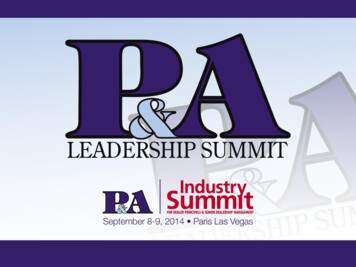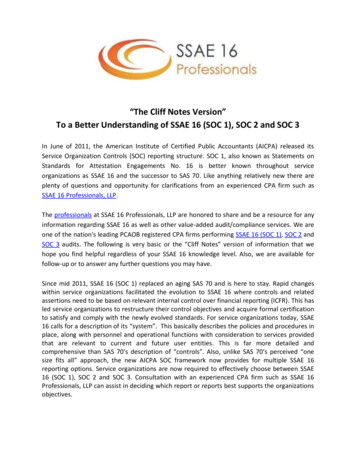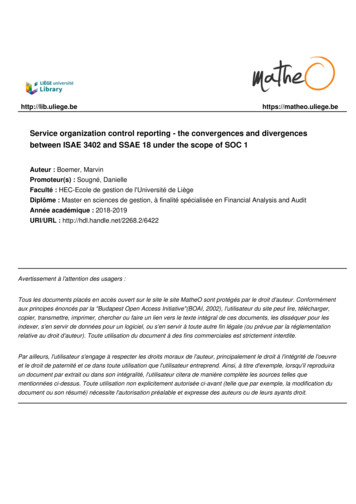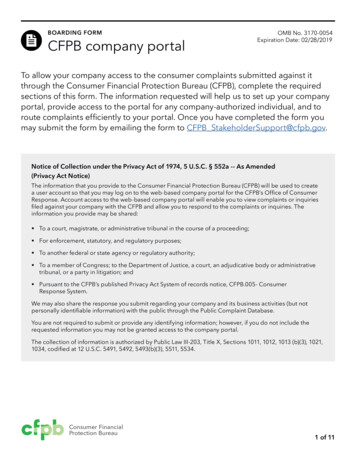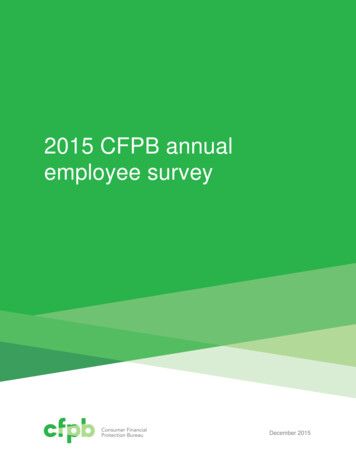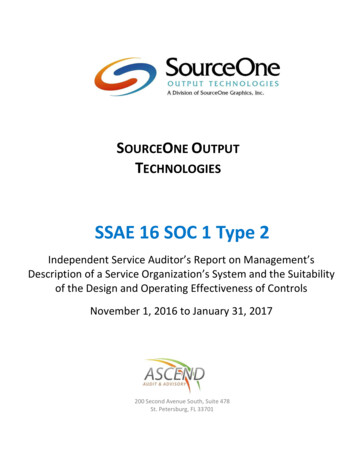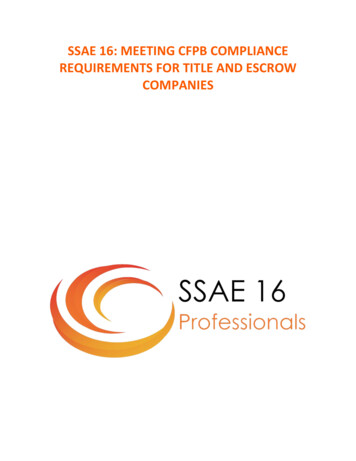
Transcription
SSAE 16: MEETING CFPB COMPLIANCEREQUIREMENTS FOR TITLE AND ESCROWCOMPANIES
ContentsSSAE 16 AND ALTA: THE COMPLIANCE VEHICLE OF CHOICE . 1THE ALTA BEST PRACTICES FRAMEWORK . 1EIC MODEL POLICIES AND PROCEDURES . 2CHOOSING THE RIGHT COMPLIANCE FRAMEWORK . 2ABOUT SSAE 16 AND SOC 2 REPORTS . 3DO TITLE AND ESCROW COMPANIES NEED BOTH THE SSAE 16 AND SOC 2 AUDIT . 4SSAE 16 AUDIT BENEFITS TO TITLE AND EXCROW SERVICE ORGANIZATIONS . 4CHOOSING THE RIGHT CPA FIRM TO PERFORM YOUR AUDIT . 5ABOUT SSAE 16 PROFESSIONALS. 7CONTACT SSAE 16 PROFESSIONALS. 7
SSAE 16: MEETING CFPB COMPLIANCE REQUIREMENTS FOR TITLE AND ESCROW COMPANIESOn April 13, 2012 the Consumer Financial Protection Bureau (CFPB) issued Bulletin 2012-03 titled"Service Providers". The CFPB bulletin included expectations around supervised banks andnonbanks (i.e. lenders) to oversee business relationships with their service providers in a mannerthat ensures compliance with Federal consumer financial law, which is designed to protect theinterests of consumers and avoid consumer harm.SSAE 16 AND ALTA: THE COMPLIANCE VEHICLE OF CHOICEThe title and escrow marketplace has been baffled on the best way to demonstrate adherenceto the new CFPB guidance. Amid the fog of uncertainty, the SSAE 16 (also known as SOC 1 audits)audit is the prevailing compliance vehicle of choice when meeting the CFPB requirements. Inresponse to the CFPB bulletin, many title and escrow companies have been in search of specificguidance to follow to come into compliance. One of the more popular sources of guidance hascome from the American Land Title Association (ALTA ). ALTA has created the Title Insuranceand Settlement Company Best Practices. To test compliance with these best practices, many inthe title and escrow industry are using the SSAE 16 audit as the “go-to” compliance vehicle ofchoice.THE ALTA BEST PRACTICES FRAMEWORKALTA developed their Best Practices Framework in 2013. This framework was established so thattitle insurance and settlement companies can assist lenders in risk management associated withthird party vendors. The ALTA Best Practices Framework consists of the following seven pillars:1. Establish and maintain current License(s) as required to conduct the business of titleinsurance and settlement services.2. Adopt and maintain appropriate written procedures and controls for Escrow TrustAccounts allowing for electronic verification of reconciliation.3. Adopt and maintain a written privacy and information security program to protect Nonpublic Personal Information as required by local, state and federal law.4. Adopt standard real estate settlement procedures and policies that help ensurecompliance with Federal and State Consumer Financial Laws as applicable to theSettlement process.5. Adopt and maintain written procedures related to title policy production, delivery,reporting and premium remittance.6. Maintain appropriate professional liability insurance and fidelity coverage.7. Adopt and maintain written procedures for resolving consumer complaints.1 Page
SSAE 16: MEETING CFPB COMPLIANCE REQUIREMENTS FOR TITLE AND ESCROW COMPANIESWhile some title and escrow companies may find these requirements mirror their existingstandard operating procedures, there are many more companies that find this entire process notonly daunting, but also extremely confusing. To further complicate matters, escrow companiesin “escrow states” may not feel comfortable following the ALTA Best Practices Framework.EIC MODEL POLICIES AND PROCEDURESA similar, but competing set of requirements has been developed by the Escrow Institute ofCalifornia (EIC), known as the “EIC Model Policies and Procedures”. This is a compliance standardfor escrow/settlement companies and provides an overview of the legal and regulatoryrequirements under state and federal laws and regulations. The EIC Model Policies andProcedures, along with the control framework to meet the requirement, may be used with anyresponse or communication with title/settlement providers, real estate professionals, lendersand consumers.The EIC Model Policies and Procedures are made up of the following six sections:1.2.3.4.5.6.LicensingInsurance & BondingPersonnel/EmploymentTrust Accounting/Funds Handling ProcedurePrivacy PolicyConsumer ComplaintsCHOOSING THE RIGHT COMPLIANCE FRAMEWORKChoosing the right compliance framework is important. If not properly planned, choosing theright framework can be both costly and frustrating. Choosing the wrong framework wouldrequire internal resources to redouble efforts, something that can be catastrophic for a smallbusiness. Every situation is different and many factors come in to play in regards whichcompliance framework should be chosen. Every situation is different, so gathering advice from areputable CPA firm with expertise in financial services is the best place to start.2 Page
SSAE 16: MEETING CFPB COMPLIANCE REQUIREMENTS FOR TITLE AND ESCROW COMPANIESABOUT SSAE 16 AND SOC 2 REPORTSSSAE 16 Reports are prepared in accordance with Statement on Standards for AttestationEngagements (SSAE) No. 16, Reporting on Controls at a Service Organization. SSAE 16 reportsretain the original purpose of the predecessor SAS 70 audit, by providing a means of reportingon the system of internal control for purposes of complying with internal control over financialreporting (ICFR). SSAE 16 reports are meant to audit business process controls that yourcustomers rely upon and outsource to your company.For reports that are not specifically focused internal controls over financial reporting, the AICPAhas issued an Interpretation under AT section 101 permitting service auditors to issuereports. These reports are now known as Service Organization Control (SOC) 2 reports and focuson controls at a service organization relevant to the following Trust Service Principles and Criteria: Security: The system is protected against unauthorized access, use, or modification.Availability: The system is available for operation and use as committed or agreed.Processing Integrity: System processing is complete, valid, accurate, timely, andauthorized.Confidentiality: Information designated as confidential is protected as committed oragreed.Privacy: The system’s collection, use, retention, disclosure, and disposal of personalinformation are in conformity with the commitments in the service organization’s privacynotice and with criteria set forth in the Generally Accepted Privacy Principles (GAPP)issued by the AICPA and CPA Canada.Both SSAE 16 or SOC 2 Type I and Type II reports can be issued: Type I – a Type I is a report on policies and procedures placed in operation as of a specifiedpoint in time. SSAE 16 or SOC 2 Type I Reports evaluate the design effectiveness of aservice provider’s controls and then confirms that these controls have been placed inoperation as of a specific date.Type II – a Type II is a report on policies and procedures placed in operation and tests ofoperating effectiveness for a period of time. SSAE 16 or SOC 2 Type II Reports include theexamination and confirmation steps involved in a Type I examination plus include anevaluation of the operating effectiveness of the controls for a period of at least sixcalendar months. Most user organizations require their service provider to undergo theType II level examination for the greater level of assurance it provides.3 Page
SSAE 16: MEETING CFPB COMPLIANCE REQUIREMENTS FOR TITLE AND ESCROW COMPANIESDO TITLE AND ESCROW COMPANIES NEED BOTH THE SSAE 16 AND SOC 2 AUDITSome CPA firms are pushing their title and escrow companies to perform both audits (a SOC 2audit covering the ALTA pillar #3 and an SSAE 16 covering the 6 remaining pillars). However, SSAE16 Professionals has a different, more cost-effective point-of-view. They recommend that unlessyou are being absolutely forced to perform both audits, only choose to undergo the SSAE 16audit. Given the flexibility the SSAE 16 audit provides, you can include the ALTA pillar #3 as acontrol objective within the SSAE 16 audit report. This approach will save both time and moneywhen undergoing the audit.SSAE 16 AUDIT BENEFITS TO TITLE AND EXCROW SERVICE ORGANIZATIONSTitle and escrow companies that invest in the SSAE 16 and/or the SOC 2 audit will experience thefollowing benefits to their organization: CFPB Regulatory Requirement – With the CFPB requiring controls around your criticalprocesses, the audit is a way to prove your company is in compliance with theirregulations.Annual Investment – Many companies view SSAE 16 audits as an annual investment witha proven ROI, increasing your prospective client base, organizational productivity,customer retention and accountability.Financial Audit Requirement for Public Companies - Auditors of your Clients will increasetheir scrutiny of the “system of internal control” during their audits of the financialstatements (Sarbanes-Oxley), which will result in more requests for your SSAE 16 report.Competitive Advantage - SSAE 16 compliance can be a key differentiator to yourprospective clients.One Time Audit - Avoids user auditors (auditors of your clients) continuously contactingyour personnel for separate audits throughout the year. Rather, your clients request andrely on the SSAE 16 report.Increased Trust and Transparency with Customers - Customer are more likely to trust yourorganization with their data or performing an important business process on their behalfbecause they will have the ability to review your SSAE 16 report and verify theeffectiveness of your controls. This allows your customers to manage their risks andexposures while outsourcing key business services to your company.Increased Investor Confidence – Many investors, including venture capitalists and angels,require the companies they invest in to perform annual SSAE 16 audits. The SSAE 16 auditallows the investors to manage their risk by ensuring effective internal controls are inplace.4 Page
SSAE 16: MEETING CFPB COMPLIANCE REQUIREMENTS FOR TITLE AND ESCROW COMPANIES Build Efficiencies with RFP’s – If your company receives RFP’s throughout the year fromclient prospects, your SSAE 16 can reduce the overall effort in completing the RFP. Clientprospects are concerned with risks to their information, many of which will beindependently tested within the SSAE 16 report. Additionally, if your company does notperform a SSAE 16 and the RFP includes a question requiring the report, you face thepossibility of being eliminated from the bidding process, even if you are the most qualifiedservice provider.CHOOSING THE RIGHT CPA FIRM TO PERFORM YOUR AUDITSome companies are so confused, they do not know who to turn to or how to get started. Byperforming hundreds of these audits annually, SSAE 16 Professionals, LLP (SSAE 16 Professionals)can assist you in a cost effective manner. However, simply performing a large number of SSAE 16audits isn’t enough. Title and Escrow companies are a special industry that requires experiencedfinancial services industry personnel to perform the audit. SSAE 16 Professionals has devoted ateam from its Financial Services Practice that is dedicated to providing specific and practicalguidance to the marketplace. With all the confusion surrounding the SSAE 16 audit process andhow it can be tailored to meet ALTA’s requirements, the Senior Leadership team at SSAE 16Professionals has made a concerted effort to educate the marketplace.Choosing the right CPA firm is the first critical decision when undergoing the SSAE 16 audit. Unlikemany CPA firms who are who perform a wide variety of services without a true specialty, SSAE16 Professionals is dedicated to performing SSAE 16 and SOC 2 audits. Below is what separatesSSAE 16 Professionals from the rest of the pack: Experience – The SSAE 16 Professionals’ leadership team has over 80 years of businessmanagement, operations, and information technology (IT) experience. Each of theirprofessionals has over 10 years of relevant experience at "Big 4" and other largeinternational or regional accounting firms. Each professional carries one or more of thefollowing designations: CPA (Certified Public Accountant), CISA (Certified InformationSystems Auditor), CIA (Certified Internal Auditor), CRISC (Certified in Risk and InformationSystems Control), and/or CISSP (Certified Information Systems Security Professional).Staff members are treated as valued and highly talented peers, allowing the firm to passon the cost-savings to the valued client.PCAOB Registered – As a registered CPA firm with the Public Company AccountingOversight Board (PCAOB), both your management team and your clients can rest assuredthat SSAE 16 Professionals is upheld to the strictest of auditing standards.5 Page
SSAE 16: MEETING CFPB COMPLIANCE REQUIREMENTS FOR TITLE AND ESCROW COMPANIES Resources – SSAE 16 Professionals takes pride in working closely and collaboratively withtheir clients to ensure all service related risks are addressed with appropriate controlobjectives and control activities. Utilizing a detailed approach also helps to identifyopportunities for improvement within their clients' operations. A proven methodology,flexible delivery methods, efficient economic operating model, and focus on adding valuefor their clients is evident in everything they do.Fixed Fee Engagements – Many firms quote a low fee with a lot of assumptions and thenhit the client with change orders when the work inevitably takes longer. A quote fromSSAE 16 Professionals is set in stone (fixed fee), and they will write off any excess time toget the work done properly (any time incurred on top of the fixed fee quote would beconsidered a first year investment in hopes of establishing a long-term SSAE 16relationship with their clients).Full Readiness – The SSAE 16 Professionals readiness methodology is much more detailedthan others who quote a low fee and then highly gloss over selected areas. SSAE 16Professionals performs a full/complete SSAE 16 readiness run through of allcontrols/areas and provide detail on what needs to be done to pass every test associatedwith general controls and application level controls.What You See is What You Get: Unlike many other firms, the Partners, Directors, andManagers at SSAE 16 Professionals take a very active role in each engagement. Theleadership team does not disappear after the proposal process.Local Decision Making: Although SSAE 16 Professionals has the resources of national and"Big 4" firms, they are not required to consult with a regional or national office when adecision needs to be made. The decision makers will be part of the audit process fromthe start of the engagement and all of decisions will be made locally. Their clients havefound that working directly with the decision makers in the firm allows for much quickerdecisions and the timely resolution of issues.Effective Planning at the Beginning of the Audit: Unlike many firms, the audit planning istaken very seriously at SSAE 16 Professionals. Detailed audit planning will be conductedand will involve all members of the engagement team. This form of planning ensures thatall significant issues are identified and addressed at the beginning of the audit, not at theend. The audit process is risk-based and the appropriate amount of time and effort isspent on the important facets of the audit. This upfront planning also ensures that theaudit will be completed in a timely manner to meet client contractual obligations or otherorganizational needs.Ultimate Support Behind Every Engagement: Performing an SSAE 16 audit is a bigaccomplishment. SSAE 16 Professionals publicly announces each successful engagement6 Page
SSAE 16: MEETING CFPB COMPLIANCE REQUIREMENTS FOR TITLE AND ESCROW COMPANIESthrough a formal press release that is drafted with input from the client’s marketingteam. The press release is sent to major search engines like Google, Yahoo! News, andBing. Additionally, the press release is sent to 30,000 journalists, bloggers, and 250,000 opt-in news subscribers.ABOUT SSAE 16 PROFESSIONALSSSAE 16 Professionals services clients across a wide range of industries throughout the UnitedStates and the world. The leadership of SSAE 16 Professionals has operated highly successfulaudit and consulting service firms for over a decade. Combined, the leadership team has over 80years of business management, operations and related information technology (IT)experience. Instead of providing a wide range of client services, the firm focuses solely onperforming SSAE 16 audits, SOC 2 audits, applicable readiness assessments, and other IT auditand compliance reports.SSAE 16 Professionals was founded in early 2008 to counter the falling economy by providingclients with top professional talent and exceptional value from a boutique-type professionalservices firm. The leadership team has collectively performed over 500 SOC audits and applicablereadiness assessments. Each of professional has over 10 years of relevant experience at "Big 4"and other large international or regional accounting firms, and most carry the designation ofCertified Public Accountant ("CPA"), Certified Information Systems Auditor ("CISA"), CertifiedInformation Systems Manager ("CISM"), or Certified Internal Auditor ("CIA"). Valued staffmembers are treated as highly talented peers, while omitting avoidable layers of managementand associated costs. More can be learned about the firm by visiting their website atwww.ssae16professionals.com.CONTACT SSAE 16 PROFESSIONALSSSAE 16 Professionals has assembled top tier leadership to help their clients through the SSAE 16process. For further information regarding SSAE 16 reports, or to request a fee proposal fromSSAE 16 Professionals, please visit their “Contact Us” page to submit an informational form orcall 866.480.9485 today. Or, feel free to contact the SSAE 16 Practice Leader directly:Tim Roncevich, CISA SSAE 16 Professionals, LLPSSAE 16 & SOC 2 Practice LeaderT/ 866.480.9485E/ ContactUs@SSAE16Professionals.com7 Page
Engagements (SSAE) No. 16, Reporting on Controls at a Service Organization. SSAE 16 reports retain the original purpose of the predecessor SAS 70 audit, by providing a means of reporting on the system of internal control for purposes of complying with internal control over financial reporting (ICFR). SSAE 16 reports are meant to audit business .
